Gouldian finch
| Gouldian finch | |
|---|---|
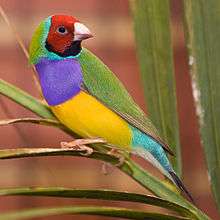 | |
| Adult red-headed male | |
| Scientific classification | |
| Kingdom: | Animalia |
| Phylum: | Chordata |
| Class: | Aves |
| Order: | Passeriformes |
| Family: | Estrildidae |
| Genus: | Erythrura |
| Species: | E. gouldiae |
| Binomial name | |
| Erythrura gouldiae (Gould, 1844) | |
 | |
| Distribution | |
| Synonyms | |
|
Chloebia gouldiae | |
The Gouldian finch (Erythrura gouldiae), also known as the Lady Gouldian finch, Gould's finch or the rainbow finch, is a colourful passerine bird endemic to Australia. There is strong evidence of a continuing decline, even at the best-known site near Katherine in the Northern Territory. Large numbers are bred in captivity, particularly in Australia. In the state of South Australia, National Parks & Wildlife Department permit returns in the late 1990s showed that over 13,000 Gouldian finches were being kept by aviculturists. If extrapolated to an Australia-wide figure this would result in a total of over 100,000 birds. In 1992, it was classified as "endangered in the wild" under IUCN's criteria C2ai. This was because the viable population size was estimated to be less than 2,500 mature individuals, no permanent subpopulation was known to contain more than 250 mature individuals, and that a continuing decline was observed in the number of mature individuals. It is currently subject to a conservation program.
Taxonomy
The Gouldian finch was described by British ornithological artist John Gould in 1844 and named after his wife Elizabeth. It is also known in America as the rainbow finch, Gould's finch, or the Lady Gouldian finch (although Mrs. Gould did not hold the title lady). In Australia, it is predominantly called the Gouldian finch. It is a member of the weaver-finch family Estrildidae, which is sometimes considered a subfamily of Passeridae.
Origin
Origin and phylogeny has been obtained by Antonio Arnaiz-Villena et al.[2] Estrildinae may have originated in India and dispersed thereafter (towards Africa and Pacific Ocean habitats).
Description

Both sexes are brightly coloured with black, green, yellow, and red markings. The females tend to be less brightly coloured. One major difference between the sexes is that the male's chest is purple, while the female's is a lighter mauve.
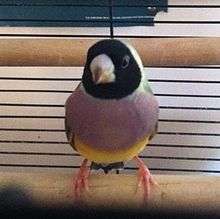
Gouldian finches are about 130–140 mm long. Gouldian finches' heads may be red, black, or yellow. Formerly considered three different kinds of finches, it is now known that these are colour variants that exist in the wild.[3] Selective breeding has also developed mutations (blue, yellow and silver instead of a green back) in both body and breast colour.
Juveniles also have distinctive colours. Their heads, sides and necks are grey, and their backs, wings and tail feathers are olive green. Their undersides are pale brown. Beaks are blackish with a reddish tip. Their legs and feet are light brown. Newly hatched Gouldian finches are pink and naked until about 12 days old when the beginnings of feathers start to appear. Very young birds, like many other species of Australian cavity-nesting finches, have a variety of odd features in and around their mouths including a "palate marked in the fashion of a domino" and several "prominent rounded tubercles" with an "opalescent lustre" at the back of the gape. These tubercles are commonly (and incorrectly) described as phosphorescent in spite of much scientific evidence to the contrary.[4] It is believed that these tubercles simply reflect light and are not luminescent.[4] Scientists have hypothesized that this domino-like palate and striking tubercles may facilitate feeding within the dark confines of a nest cavity, although no experiments have been conducted to support this idea.
Distribution and habitat
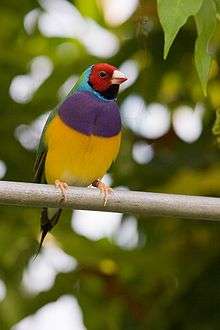
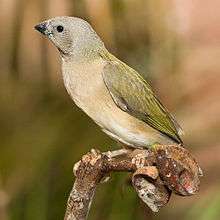
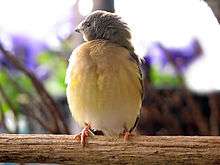
These birds are found in northern Australia, from the Cape York Peninsula through north-west Queensland and the northern Northern Territory to the Kimberley region of Western Australia. Their habitat is tropical savannah woodlands. The birds are nomadic within a relatively small area (approximately 40 square kilometres) and only move when water or food becomes scarce. The largest known wild population of the species is found in the Bastion Hills, next to the town of Wyndham in the eastern Kimberley, where a 28 km2 site – the Wyndham Important Bird Area – has been identified by BirdLife International.[5]
Prior to the Australian government's ban on the export of Australian fauna in 1959, Gouldian finches were exported worldwide. These birds have resulted in viable breeding populations being held in many countries.
Captive breeding has resulted in several colour mutations to the back and two mutations to the breast. Mutations vary by country, with some existing only in Australia (the Australian yellow and the Australian "dilute") and others existing in greater number in the United States, such as the blue bodied Gouldian. The most common body mutations in the United States are blue, pastel green (single and double-factor, resulting in "dilute" and yellow males and yellow females), and pastel blue (again, single and double-factor producing "pastel" and silver males, and silver hens).[6] There is also a lutino and albino mutation in the United States, established by Winnie McAlpin of Delmar Aviaries.[7]
Conservation status
The number of Gouldian finches has decreased quite dramatically during the 20th century. Their habitat has been reduced or altered. Early research indicated a parasite called the air sac mite was responsible for the decline of the species. This is no longer considered to be a major factor. In general, Gouldian finches are susceptible to diseases and viral infections. Their beautiful colours mean that they are easily caught by predators. Fires are listed as the primary threat to the natural populations. The total number of Gouldian finches altogether is not low, however, because they are among the most popular pet birds, and are bred in captivity for the pet trade.
Recovery plans are in place to recover and conserve its natural habitats, such as building protective fencing to prevent damage by cattle, research on wildfires and their effects on Gouldian population[8] and constructing artificial nest boxes in order to provide more nesting locations for wild pairs.[9] Attempts at reintroduction have so far proved unsuccessful. It was also suggested to develop management guidelines for land-holders about appropriate land management, promoting the recovery program, and Gouldian finch conservation.
Important Bird Areas
BirdLife International has identified the following sites as being important for Gouldian finches:[10]
- Northern Territory
- Western Australia
Behaviour
Outside the breeding season, Gouldian finches often join mixed flocks consisting of long-tailed finches and masked finches. This is probably a defense against predation. Flocks used to consist of up to 1,000–2,000 individuals. During the breeding season they are usually found on rough scree slopes where vegetation is sparse. In the dry season, they are more nomadic and will move to wherever there is food and water.
Feeding
Like other finches, the Gouldian finch is a seed eater. During the breeding season, Gouldian finches feed mostly on ripe or half-ripe grass seeds of sorghum. During the dry season, they forage on the ground for fallen seed. During the wet season, spinifex grass seed (Triodia sp.) is an important component of their diet. So far Gouldians have been recorded as consuming six different species of grass seed, but during crop analysis, researchers have yet to find evidence of insect consumption.
Breeding
Gouldian finches generally make their nests in tree-holes, generally within a kilometer or so of water. They usually breed in the early part of the dry season, when there is plenty of food around. The male courtship dance is a fascinating spectacle. When a male is courting a female, he bobs about ruffling his feathers to show off his colors. He expands his chest and fluffs out his forehead feathers. After mating, a female lays a clutch of about 4–8 eggs. Both parents help brood the eggs during the daytime, and the female stays on the eggs at night. When the eggs hatch, both parents help care for the young. Gouldian finches leave the nest at between 19 and 23 days and are independent at 40 days old.
Gouldian finches have brightly coloured gapes and call loudly when the parent birds return so that they are able to find and feed their mouths in the dark nest.[11]
It has been shown that female Gouldian finches from Northern Australia can control the sex of their offspring by choosing mates according to their head color. A certain amount of genetic incompatibility between black and red-headed birds can result in high mortality (up to 80%) in female offspring when birds of different head colours mate. If the female mates with a finch of different head colour, this genetic incompatibility can be addressed by over-producing sons, up to a ratio of four males to one female. This is one of the first proven instances of birds biasing the sex of their offspring to overcome genetic weaknesses.[12] [13]
Aviculture
Gouldian finches are a popular species in aviculture due to their bright colors, low maintenance, and relative easy breeding. Gouldian finches get along well with other species of grass finch as well as other docile species such as waxbills and parrot finches.
Trapping for aviculture
In the Kimberley District of Western Australia, where most wild Gouldian finch were trapped for aviculture, it was often reported as one of the more common of the eleven finch species. Until 1977, it was trapped in greater numbers than any other finch. From 1897, when finch trapping started in the Kimberley, it was the most sought after finch by trappers and the most desired by fanciers. Between the years 1934 and 1939, the Gouldian finch was the most exported single finch species. The Perth Zoo exported 22,064 finches of which 12,509 were Gouldian. Private dealers exported 35,315 finches, of which 14,504 were Gouldian. The number of finches taken in the 1958 finch trapping season was the largest for one year, of the 38,649 finches taken, 11,286 were Gouldian. The last licensed trapping of Gouldian finch in Western Australia was on 15 November 1981. In that year's finch trapping season, of the 23,450 finches taken 1,054 were Gouldian.[14]
References
- ↑ BirdLife International (2013). "Erythrura gouldiae". IUCN Red List of Threatened Species. Version 2013.2. International Union for Conservation of Nature.
- ↑ Arnaiz-Villena, A; Ruiz-del-Valle V; Gomez-Prieto P; Reguera R; Parga-Lozano C; Serrano-Vela I (2009). "Estrildinae Finches (Aves, Passeriformes) from Africa, South Asia and Australia: a Molecular Phylogeographic Study" (PDF). The Open Ornithology Journal. 2: 29–36. doi:10.2174/1874453200902010029.
- ↑ Southern H.N. (1945). "Polymorphism in Poephila gouldiae" (PDF). J. Genet. 47: 51–157. doi:10.1007/BF02989037.
- 1 2 McAtee W.L. (1947). "Luminosity in Birds". American Midland Naturalist. 38: 207–213. doi:10.2307/2421636. JSTOR 2421636.
- ↑ BirdLife International. (2011). Important Bird Areas factsheet: Wyndham.
- ↑ Gouldian Body Color Genetics. Gouldiansgalore.com. Retrieved on 2013-08-30.
- ↑ Delmar Gouldian Finches – Home. Gfinches2.com. Retrieved on 2013-08-30.
- ↑ Fire Management. How are Gouldians affected by wildfires? Save The Gouldian Fund. Savethegouldian.net. Retrieved on 2013-08-30.
- ↑ Project. Why do wild Gouldians need new homes? Save The Gouldian Fund. Savethegouldian.net. Retrieved on 2013-08-30.
- ↑ BirdLife International. (2013). Gouldian Finch Erythrura gouldiae.
- ↑ Attenbourgh, David. The Life of Birds, Episode 9, 3 mins, 55 s.
- ↑ Pryke, S.R.; Griffith, S.C. (2009). "Genetic incompatibility drives sex allocation and maternal investment in a polymorphic finch". Science. pp. 1605–1607.
- ↑ "Bird Controls Offspring's Gender". Scientific American.
- ↑ Finch Trapping in the Kimberley, K H Coate and L H Merritt (2015) ISBN 978-0-85905-621-2 - ref Fisheries Department, table, trapped birds export statistics 1935-1939 22 August 1939, SROWA CONS 477, ITEM 1934-0059; and Department of Conservation and Land Management, table, Annual Finch Trapping Since 1968 1986. SROWA CONS 6437, ITEM 014832F3528
Gallery
Gouldian finch mutations
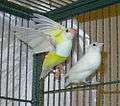 White Gouldian finch and yellow Gouldian finch mutation
White Gouldian finch and yellow Gouldian finch mutation White-breasted yellow-headed Gouldian finch (left) and black-headed male Gouldian finches
White-breasted yellow-headed Gouldian finch (left) and black-headed male Gouldian finches Adult male double factor yellow back Gouldian finch
Adult male double factor yellow back Gouldian finch
External links
| Wikimedia Commons has media related to Chloebia gouldiae. |
